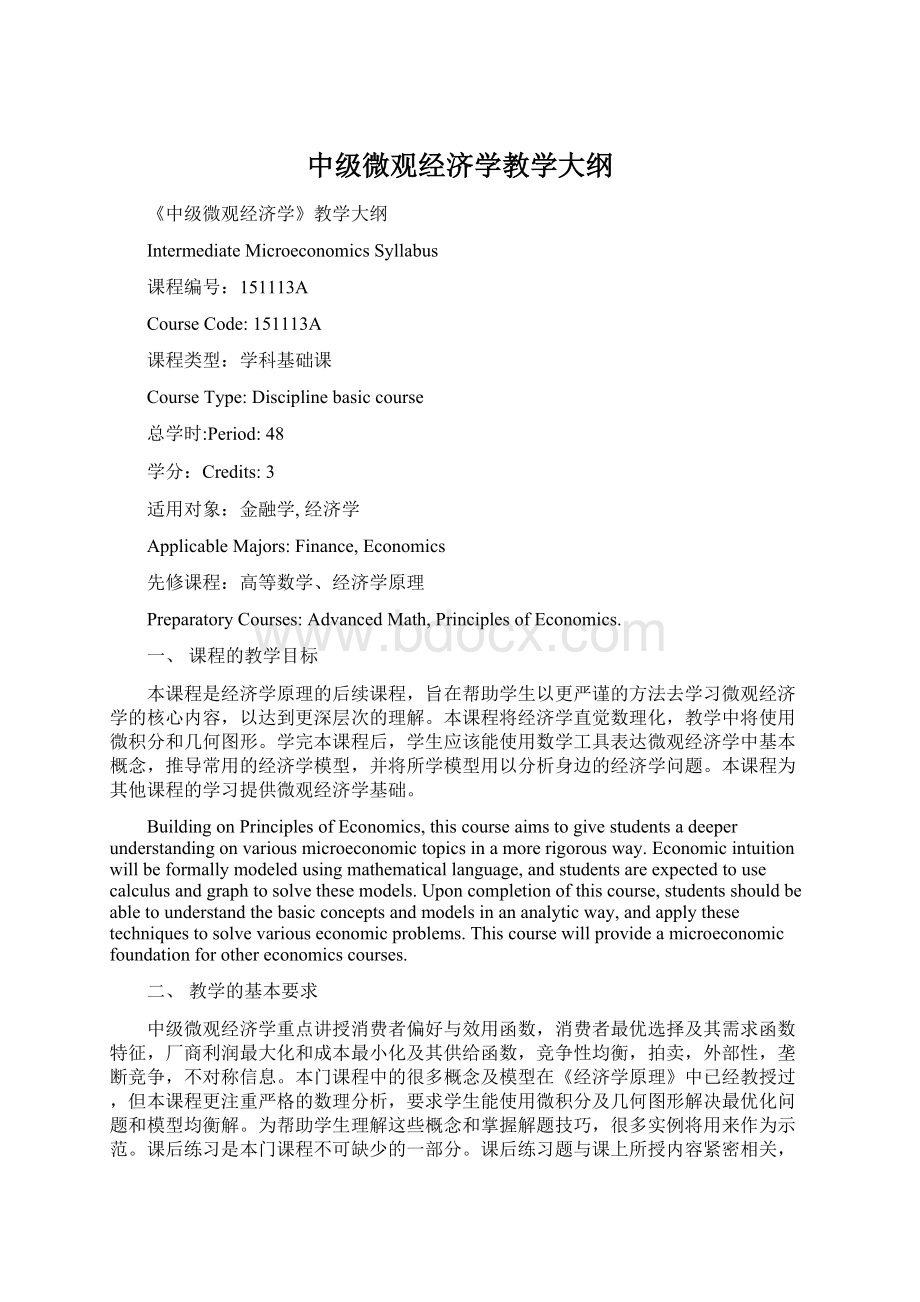中级微观经济学教学大纲.docx
《中级微观经济学教学大纲.docx》由会员分享,可在线阅读,更多相关《中级微观经济学教学大纲.docx(13页珍藏版)》请在冰豆网上搜索。

中级微观经济学教学大纲
《中级微观经济学》教学大纲
IntermediateMicroeconomicsSyllabus
课程编号:
151113A
CourseCode:
151113A
课程类型:
学科基础课
CourseType:
Disciplinebasiccourse
总学时:
Period:
48
学分:
Credits:
3
适用对象:
金融学,经济学
ApplicableMajors:
Finance,Economics
先修课程:
高等数学、经济学原理
PreparatoryCourses:
AdvancedMath,PrinciplesofEconomics.
一、课程的教学目标
本课程是经济学原理的后续课程,旨在帮助学生以更严谨的方法去学习微观经济学的核心内容,以达到更深层次的理解。
本课程将经济学直觉数理化,教学中将使用微积分和几何图形。
学完本课程后,学生应该能使用数学工具表达微观经济学中基本概念,推导常用的经济学模型,并将所学模型用以分析身边的经济学问题。
本课程为其他课程的学习提供微观经济学基础。
BuildingonPrinciplesofEconomics,thiscourseaimstogivestudentsadeeperunderstandingonvariousmicroeconomictopicsinamorerigorousway.Economicintuitionwillbeformallymodeledusingmathematicallanguage,andstudentsareexpectedtousecalculusandgraphtosolvethesemodels.Uponcompletionofthiscourse,studentsshouldbeabletounderstandthebasicconceptsandmodelsinananalyticway,andapplythesetechniquestosolvevariouseconomicproblems.Thiscoursewillprovideamicroeconomicfoundationforothereconomicscourses.
二、教学的基本要求
中级微观经济学重点讲授消费者偏好与效用函数,消费者最优选择及其需求函数特征,厂商利润最大化和成本最小化及其供给函数,竞争性均衡,拍卖,外部性,垄断竞争,不对称信息。
本门课程中的很多概念及模型在《经济学原理》中已经教授过,但本课程更注重严格的数理分析,要求学生能使用微积分及几何图形解决最优化问题和模型均衡解。
为帮助学生理解这些概念和掌握解题技巧,很多实例将用来作为示范。
课后练习是本门课程不可缺少的一部分。
课后练习题与课上所授内容紧密相关,旨在让学生通过反复练习以达到掌握。
课程考核由四部分组成,分别是平时作业20%,课堂测验10%,期中闭卷考试30%,期末闭卷考试40%。
Thiscoursewillfocusonthestudyofconsumerpreferenceanditsutilityrepresentation,consumers’optimalchoiceandthepropertiesofdemandfunctions,firms’optimizationproblemandsupplyfunction,theinteractionofdemandandsupplythroughcompetitiveequilibrium,auction,monopolisticcompetition,externalities,andasymmetricinformation.TheseconceptsandmodelshavebeenintroducedinPrincipleofEconomics;however,theywillbeexaminedinamorerigorousway,requiringstudentssolvingoptimizationandequilibriumproblembycalculusandgraph.Tohelpstudentsunderstandtheconceptsandtoillustratetheusefulnessofeconomicsmodels,concreteexampleswillbeusedthroughouttheteaching.Homeworkisanintegratedpartofthiscourse.Homeworkquestionsfollowlecturenotesclosely,andaredesignedtohelpstudentslearntheconceptsandtechniquesbysolvingproblems.Thegradesincludefourparts,homework,quiz,midtermexamandfinalexam.Homeworkcountsfor20%ofthefinalgrade,quizcountsfor10%ofthefinalgrade,midtermexamcountsfor30%ofthefinalgrade,finalexamcountsfor40%ofthefinalgrade.
三、各教学环节学时分配
教学课时分配
序号
章节内容
讲课
实验
其他
合计
1
偏好与效用
PreferenceandUtility
3
2
预算约束
BudgetConstraint
3
Homework1
3
消费者选择
ConsumerChoice
3
4
需求
Demand
3
Homework2
5
显示性偏好
RevealedPreference
3
6
斯拉茨基方程
SlutskyEquation
3
Homework3
7
买与卖
BuyingandSelling
3
8
消费者剩余
Consumer’sSurplus
3
Homework4
9
均衡
Equilibrium
3
10
利润最大化
ProfitMaximization
3
Homework5
11
成本最小化
CostMinimization
3
12
产业供给
IndustrialSupply
3
Homework6
13
拍卖
Auction
3
14
外部性
Externalities
3
Homework7
15
垄断行为
MonopolyBehavior
3
16
不对称信息
AsymmetricInformation
3
Homework8
合计
48
四、教学内容
第一章偏好与效用
CHAPTERI:
PreferenceandUtility
第一节关于偏好的假设
PART1Assumptionsaboutpreferences
第二节无差异曲线
PART2Indifferencecurves
第三节边际替代率
PART3Themarginalrateofsubstitution
第四节构建效用函数
PART4Constructingautilityfunction
第五节边际效用
PART5Marginalutility
教学重点、难点:
效用函数的排序特性,边际替代率的含义。
KeyPoints:
theordinalpropertyofutilityfunctionandthemeaningofthemarginalrateofsubstitution.
课程的考核要求:
理解效用函数的排序特性,掌握边际替代率的含义与计算。
Requirement:
understandtheordinalpropertyofutilityfunction,masterthemeaningandcalculationofthemarginalrateofsubstitution.
第二章:
预算约束
CHAPTER2:
BudgetConstraint
第一节预算约束
PART1Thebudgetconstraint
第二节预算约束特征
PART2Propertiesofthebudgetconstraint
第三节预算线的变动
PART3Howthebudgetlinechanges
第四节税收,补贴和配额
PART4Taxes,subsidies,andrationing
教学重点、难点:
预算约束线如何受收入,价格和经济政策影响而变动。
KeyPoints:
howthebudgetlinechangeswithrespecttoincome,pricesandeconomicpolicy.
课程的考核要求:
熟练掌握预算约束线如何受收入,价格和经济政策影响而变动。
Requirement:
masterhowthebudgetlinechangeswithrespecttoincome,pricesandeconomicpolicy.
第三章消费者选择
CHAPTER3ConsumerChoice
第一节最优选择
PART1Optimalchoice
第二节估计效用函数
PART2Estimatingautilityfunction
第三节估计效用函数
PART3ImplicationsoftheMRScondition
第四节税收的选择
PART4Choosingtaxes
教学重点、难点:
最优选择的求解,估计效用函数,税收对最优选择的影响。
KeyPoints:
solvingtheoptimalchoice,estimatetheutilityfunction,analysisoftaxeffectonoptimalchoice.
课程的考核要求:
理解如何估计效用函数,掌握最优选择的求解,并会分析税收对最优选择的影响。
Requirement:
understandestimatingtheutilityfunction,masterthetechniqueofsolvingtheoptimalchoice,analyzingtaxeffectonoptimalchoice.
第四章需求
CHAPTER4Demand
第一节正常品与劣质品
PART1Normalandinferiorgoods
第二节恩格尔曲线
PART2Englecurve
第三节吉芬品
PART3Giffengoods
第四节需求曲线
PART4Demandcurve
教学重点、难点:
恩格尔曲线,劣质品和吉芬品之间的关系。
KeyPoints:
Englecurve,therelationbetweeninferiorgoodsandGiffengoods.
课程的考核要求:
理解恩格尔曲线的定义,以及劣质品和吉芬品之间的关系。
Requirement:
understandthedefinitionofEnglecurve,andtherelationbetweeninferiorgoodsandGiffengoods.
第五章显示性偏好
CHAPTER5RevealedPreference
第一节显示性偏好的思想
PART1Theideaofrevealedpreference
第二节弱显示性偏好公理
PART2TheWeakAxiomofRevealedPreference
第三节强显示性偏好公理
PART3TheStrongAxiomofRevealedPreference
教学重点、难点:
弱(强)显示性偏好公理。
KeyPoints:
Weak(Strong)AxiomofRevealedpreference.
课程的考核要求:
掌握如何检验消费数据是否满足弱(强)显示性偏好公理。
Requirement:
masterhowtocheckwhethergivendatasatisfiesWeak(Strong)AxiomofRevealedpreference.
第六章斯拉茨基方程
CHAPTER6SlutskyEquation
第一节替代效应
PART1Substituteeffect
第二节收入效应
PART2Incomeeffect
第三节需求的总变动
PART3Thetotalchangeindemand
第四节需求定律
PART4Thelawofdemand
第五节补偿需求曲线
PART5Compensateddemandcurves
教学重点、难点:
替代效应和收入效应,斯拉茨基方程的推导。
KeyPoints:
substituteeffectandincomeeffect,andthederivationofSlutskyequation.
课程的考核要求:
理解替代效应和收入效应,掌握斯拉茨基方程的推导。
Requirement:
understandthedefinitionofsubstituteeffectandincomeeffect,masterthederivationofSlutskyequation.
第七章买与卖
CHAPTER7BuyingandSelling
第一节净需求与总需求
PART1Netandgrossdemands
第二节禀赋的改变
PART2Changingtheendowment
第三节价格变动
PART3Pricechanges
第四节斯拉茨基方程
PART4TheSlutskyequationrevisited
第五节劳动供给
PART5Laborsupply
教学重点、难点:
禀赋变动对需求的影响,存在禀赋时斯拉茨基方程的推导。
KeyPoints:
theeffectofendowmentondemand,Slutskyequationwhenthereisendowment.
课程的考核要求:
理解禀赋变动对需求的影响,掌握存在禀赋时斯拉茨基方程的推导。
Requirement:
understandtheeffectofendowmentondemand,mastertheSlutskydecompositionofdemandchangewhenthereisendowment.
第八章消费者剩余
CHAPTER8Consumer’sSurplus
第一节消费者剩余
PART1:
Consumer’ssurplus
第二节拟线性效用函数
PART2:
Quasilinearutility
第三节补偿与等价变换
PART3:
Compensatingandequivalentvariation
第四节生产者剩余
PART4:
Producer’ssurplus
第五节收益-成本分析
PART5:
Benefit-costanalysis
教学重点、难点:
消费者剩余的含义,补偿变换和等价变换之间的关系。
KeyPoints:
themeaningofconsumer’ssurplus,therelationbetweencompensatingandequivalentvariation.
课程的考核要求:
理解补偿变换和等价变换之间的关系,掌握消费者剩余的含义与计算。
Requirement:
understandtherelationbetweencompensatingandequivalentvariation,andmasterthemeaningandcalculationofconsumer’ssurplus.
第九章均衡
CHAPTER9Equilibrium
第一节市场均衡
PART1:
Marketequilibrium
第二节比较静态
PART2:
Comparativestatics
第三节税收
PART3:
Taxes
第四节帕累托有效性
PART4:
Paretoefficiency
教学重点、难点:
市场均衡的求解,市场均衡如何受经济政策影响而变动,以及市场均衡的效率性。
KeyPoints:
solvingmarketequilibrium,howmarketequilibriumchangeswithrespecttoeconomicpolicy,andtheefficiencyofmarketequilibrium.
课程的考核要求:
理解市场均衡如何受经济政策影响而变动,掌握市场均衡的求解以及市场均衡的效率性。
Requirement:
understandhowmarketequilibriumchangeswithrespecttoeconomicpolicy,masterthetechniquetofindamarketequilibrium,andtheefficiencyofmarketequilibrium.
第十章利润最大化
CHAPTER10ProfitMaximization
第一节利润
PART1:
Profits
第二节固定和可变要素
PART2:
Fixedandvariablefactors
第三节短期利润最大化
PART3:
Short-runprofitmaximization
第四节长期利润最大化
PART4:
Profitmaximizationinthelongrun
教学重点、难点:
固定和可变要素的定义,求解短期(长期)利润最大化的解。
KeyPoints:
meaningoffixedandvariablefactors,solvingshort-run(long-run)profitmaximization.
课程的考核要求:
理解固定和可变要素的定义,掌握短期(长期)利润最大化的求解。
Requirement:
understandthemeaningoffixedandvariablefactors,masterthetechniqueofsolvingshort-run(long-run)profitmaximization.
第十一章成本最小化
CHAPTER11CostMinimization
第一节成本最小化
PART1:
costminimization
第二节规模收益与成本函数
PART2:
Returntoscaleandthecostfunction
第三节长期与短期成本
PART3:
Long-runandshort-runcosts
第四节固定与沉没成本
PART4:
Fixedandsunkcosts
教学重点、难点:
求解短期(长期)成本最小化的解,以及规模收益与成本的关系。
KeyPoints:
solveshort-run(long-run)costminimization,therelationbetweenreturntoscaleandcost.
课程的考核要求:
理解规模收益与成本的关系,掌握短期(长期)成本最小化的求解。
Requirement:
understandtherelationbetweenreturntoscaleandcost,masterthetechniquetosolveshort-run(long-run)costminimization.
第十二章产业供给
CHAPTER12IndustrySupply
第一节短期产业供给
PART1:
Short-runindustrysupply
第二节长期供给曲线
PART2:
Thelong-runsupplycurve
第三节固定要素和经济租金
PART3:
Fixedfactorsandeconomicrent
第四节能源政策
PART4:
Energypolicy
教学重点、难点:
短期(长期)供给曲线的推导,经济租金的含义。
KeyPoints:
thederivationofshort-run(long-run)supplycurve,meaningofeconomicrent.
课程的考核要求:
理解
Requirement:
understandthemeaningofeconomicrent,masterthederivationofshort-run(long-run)supplycurve.
第十三章拍卖
CHAPTER13Auction
第一节拍卖的分类
PART1:
Classificationofauctions
第二节拍卖设计
PART2:
Auctiondesign
第三节位置拍卖
PART3:
Positionauction
第四节拍卖的问题
PART4:
Problemswithauctions
教学重点、难点:
不同拍卖形式的特征,位置拍卖。
KeyPoints:
thepropertiesofdifferentauctions,positionauction.
课程的考核要求:
掌握不同拍卖形式的特征,理解位置拍卖。